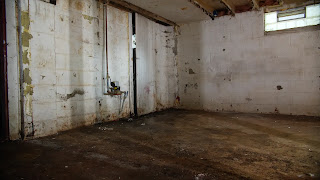If your basement's walls are nothing more than plain concrete, you should start here. Finished basement walls will make the space look finished, warm, and inviting, especially once the drywall is painted and insulation is installed.
The following are the steps for finishing your basement walls:
First Step to Basement Makeovers
Adding polystyrene foam insulation directly to your foundation walls is one of the simplest and most effective solutions to insulate a basement's outer walls.
To allow for some wiggle space during installation, cut the foam pieces to the height of your ceiling minus 14 inches.
You can use a utility knife or a circular saw to cut foam insulation. Wear protective eyewear if you're going to use a saw.
Hold your cut insulation against the wall to check that it is the correct height. Before moving on to the next step, remove it once more.
Apply the glue to the wall where the foam will be attached. Allow the time specified on the bottle to sit.
Place the sheet against the adhesive and press it down.
Repeat the process until all of the walls have been covered.
Seal the seams between each piece of foam with duct tape after it's all in place.
Finally, caulk or foam-filler any gaps between the foam and the ceiling, floor, or corners.
Create a Frame for Your Walls
Cut all of your two-by-fours to the correct length before you start creating your walls.
Subtract the thickness of the top and bottom plates and an additional 1/4 inch from the vertical wall joists. It will give you enough room to easily fit the frames against the foundation.
To build a basement wall, follow these steps:
Install blocking between the above joists and the wall for the walls that run parallel to your floor joists by screwing or nailing a fitting two-by-four to the joists. Along the parallel walls, install every 2 feet and use these blocks to connect your frames.
Draw a line 4 inches from each wall the length of the wall to align the frame's outer edge.
Build the wall on the ground, starting with the lowest plate closest to the wall. Attach the wall panels to the top and bottom plates every 16 inches using a nail gun. To account for doors and windows, move wall joists as needed.
 |
| Basement Wall Installation |
Raise the wall and align the bottom plate's outside edge with the 4-inch line.
Secure the bottom plate to the concrete floor using a masonry drill, nails, and a hammer. Use hearing protection, a dust mask, and safety eyewear during this stage.
Attach the top plate to the above joists or blocks using your framing nailer and a stepladder. Hold a level vertically against each wall joist as you work your way across the wall to ensure the wall sits flat before nailing the top plate above.
If your wall isn't level, use a shim between the top plate and ceiling joists until they are, and then nail it down with the nail gun.
Also Know - How to start Basement Remodeling?
Drywall Installation
After you've finished creating your walls, you can start hanging drywall. By measuring the location of any outlets or valves and cutting access holes into the drywall sheet with a drywall knife, you can account for them. After fastening the sheet to the wall, measure the proportions and cut the right form out of the drywall.
You can hang your drywall vertically or horizontally, but for most homes, horizontally is the best option. There will be fewer seams, and each panel will be easier to complete.
To get started, follow these steps:
Use your utility knife to cut as needed to ensure each piece of drywall ends on a stud.
Use drywall screws and a drill to secure the drywall to each stud, being careful not to rip the drywall paper surface. There should be no plaster on the nail head.
Caulk the seams and the screw heads. Finally, use drywall tape to conceal seams before repeating the caulking process.
You can also read these similar articles:




.jpg)

.jpg)

